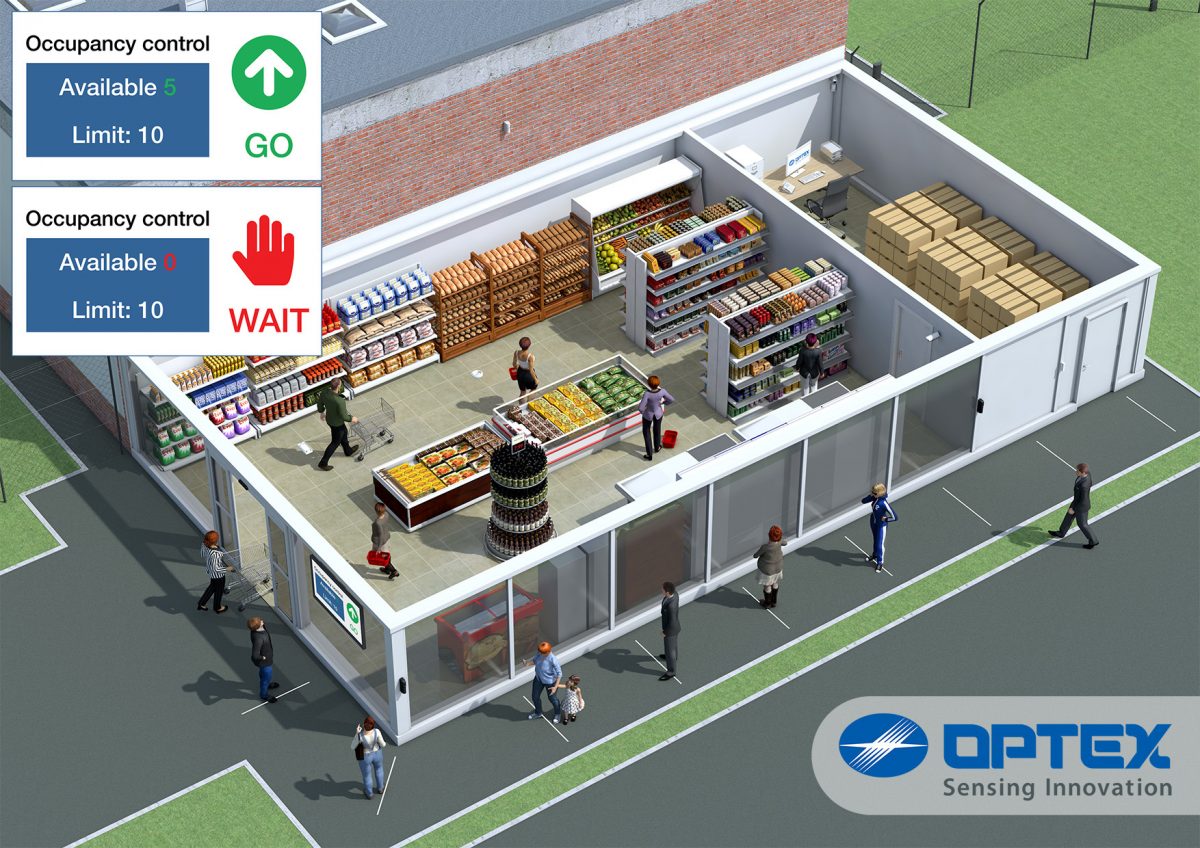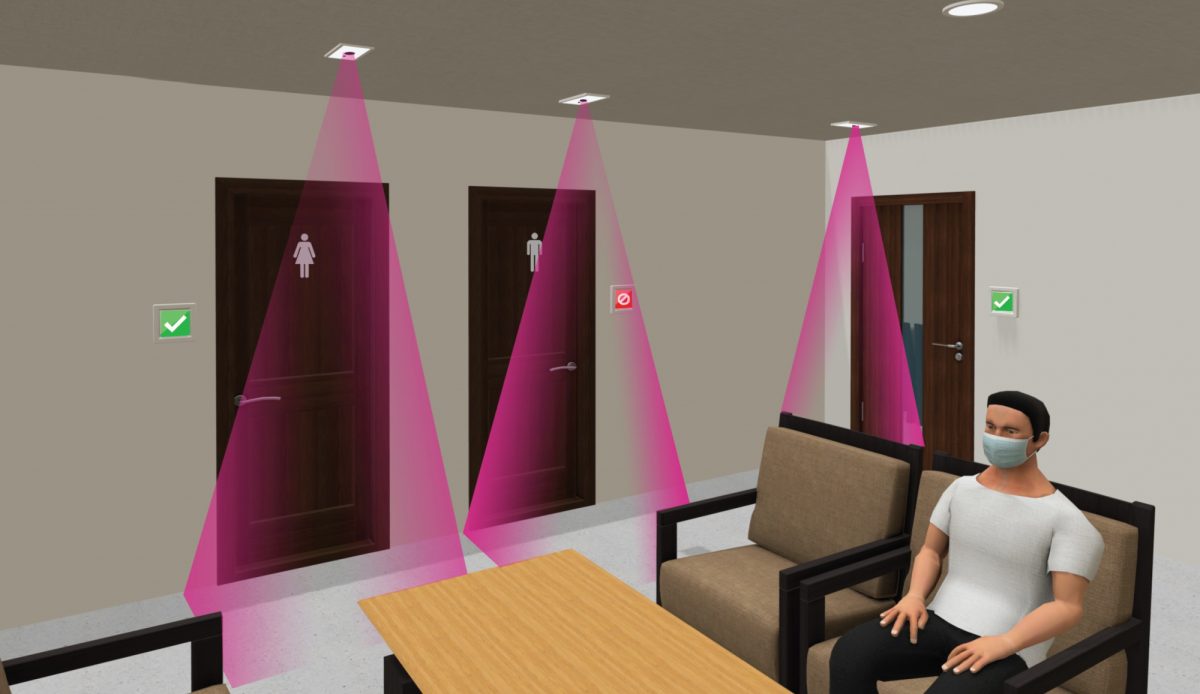28 May 2020

The Covid-19 pandemic has changed the way we manage and control the numbers and access of people into and out of our shops and offices, or indeed any building open to the public.
Until now, people access has been managed by the simple use of floor guides and tape, with staff or security guards issuing verbal instructions and direction. Very rarely, however, is the traffic inside the building (e.g the number of people per aisle or per room) being monitored. The enforcement of social distancing is therefore left to the self-discipline of individuals or to the occasional control of a member of staff, some with the use of a loud hailer.
Real time people counting solution could prove a far more efficient and accurate way to control the situation. Three of our technology partners - the Spanish company Vaelsys and the UK companies IAconnects and Xenometric – believe they have the answer by integrating our Akribos people counter and MQTT protocol together with their own software platforms to provide a workable solution.
Social distancing Room Management by IA Connects
IAconnects provides smart building control systems and is now offering a Social Distancing Room Management technology. Its solution works by monitoring the number of people and occupancy level of common areas such as waiting rooms, meeting rooms, office lobbies, washrooms etc and displaying the appropriate instruction. It might, for example, state ‘do not enter’, ‘free to go’, “cleaning required” or any other such status that the customer defines. The solution can be used for any commercial building including retail outlets with the option to display the instruction on a third-party screen and to integrate with other devices (traffic light, door, booking / office management systems) . The solution comprises our OPTEX people counting sensor VC-1020, WiFi Gateway including IAconnects MobiusFlow software and display units mounted by the doors. A web-based dashboard also provides an instant overview of the overall building status.

For more information about Social Distancing Room Management download the brochure here
Or contact IAconnects here
EasyCount and Datacenter by Vaelsys
Vaelsys is a software development company and video analytics provider which has developed several systems using our Akribos technology. Among the most recent are two types of people counting and traffic monitoring solutions: EasyCount – which enables smaller retail outlets to display the number of people allowed in and the average waiting time; and Datacentre – which is a scalable people counting and retail analytics solution suited for larger and multi-site retailers. Datacentre can generate elaborate dashboards and charts, as well as row data reports (CSV) for comparative pruposes and data analytics. Both solutions can manage and activiate I/O modules to connect with other devices such as trafiic lights, speakers and doors.

The EasyCount solution includes the storage hardware, the permanent software license to receive the count data and transform it in GO / WAIT dashboard that can be displayed on any existing monitor/ TV. It also includes the HDMI cable and Vesa mount. The Akribos people counter has to be purchased separately, as does the network switch.
For more information on EasyCount please visit https://easy-count.com/ or download the brochure
For Vaelsys DATACENTER solution please download the brochure
Xenoview and X-Server by Xenometric
The third of the new solutions comes from Xenometric, a software development company which has a particular specialism in people counting and occupancy level solutions. It has developed software packages designed to work specifically with the OPTEX Akribos people counter to suit different sizes of application and need. The entry-level solution, Xenoview, is suited to independent retailers or smaller buildings. It collects the real time count data from up to four Akribos, displays the occupancy levels on an integrated dashboard, and issue instructions to GO or WAIT. The count data is stored locally and can also be used for retail analysis purposes.
For larger or multisite applications, Xenometric has developed the X-Server. Similar to Xenoview in terms of its functionality, it differs in that it is fully scalable and includes an SQL database and full reporting functionalities. It can be hosted on the customer’s server or on the Cloud.

Xenoview is designed to be hosted on a Windows-based PC at the customer’s site. It includes a permanent license. A network switch, Akribos counter(s) and the monitor displaying the occupancy dashboard should be purchased separately. The system has the ability to manage an I/O module to interact with other devices (traffic light, audio systems etc)
To contact Xenometric please click here
Why are they using OPTEX Akribos (VC1020) people counter?
OPTEX VC-1020 with MQTT protocol
OPTEX Akribos VC-1020 is a real-time and multi-directional indoor people counter that provides up to 98% accuracy. It ignores trollies and baskets, and manages groups of individuals by tracking the direction or every individual, even if they are loitering. The counting sensor now has the ability to have the MQTT protocol embedded. The Message Queuing Telemetry Transport (MQTT) is a lightweight messaging open protocol, which manages telemetry information, and is used in Man-to-Machine M2M and IoT devices for real-time analytics, preventive maintenance monitoring etc. (source https://internetofthingsagenda.techtarget.com/definition/MQTT-MQ-Telemetry-Transport)
The MQTT protocol allows the people count to be immediately transmitted to the integrated occupancy software platform and gives an exact picture on how many people are in the shop, room or a specific area.
If you would like to know more about our Akribos people counter visit the product page or contact us.
Better Access Security with Reverse detection and Tailgating detection

In a high-security environment or anywhere where it is important to manage the flow of people, any breach of the rules need to be detected. This could be a person walking the opposite direction to where he / she should be walking or an unauthorised person following an authorised individual through an access door. OPTEX provides two detection systems that can help.
Enforcing one-way flow
It is easier to secure an area when there is a clear entry point and a one-way system leading to an exit point. Airports are designed that way where passengers are following a one-way path through security and the boarding gate, and on arrival they are channelled to passport control and baggage reclaim. No one should walk in the opposite direction, exiting the security check area or entering through the baggage claim exit door as it will create an obvious security threat.
A single direction flow of people is not only applicable for airports but across industries such museums, event venues, law enforcement institutions or anywhere where it is safer or more secure to get people moving in one direction only.

Detecting people walking in the opposite direction to an allocated channel will alert the monitoring staff of anyone not complying and allowing them to investigate why. This is exactly what our Accurance R1002 does: it provides reverse detection, comprising one PoE ceiling-mounted sensor that detects the direction people are going and a control box that communicates with a security or access control system to generate an alarm.
When mounted at 4m the unit can track the reverse detection within an area of 4m wide; three sensors can be mounted in parallel to cover an area of 11.4 m wide.
Tailgating detection (single door application)
The security of a site, intellectual property and valuable assets can be compromised if an unauthorised person manages to access a secure area. This can happen during normal office hours when an authorised member of staff is followed by an intruder without his/ her knowledge. Detecting tailgating activity is critical to alerting the security team of any breach into a controlled area. OPTEX Accurance OV-102 can detect three different types of situations:

- An individual has been followed by another one through the door. It will raise an alarm.

- A person has exited the room at the same time as another one has entered it; one of the two individuals hasn’t presented his/ her access control credentials which is a concern and needs to be reported.

- If two people are standing in an area intended to a single occupancy. In this situation the system can be configured to prevent the access door to open.
The system consists of multi-directional human sensor and counter together with a control box which manages the alarm inputs and outputs.
Tech tip Animal tolerance for outdoor detection

Following last month’s tech tip which was looking at pet tolerance for indoor alarm systems, we are now exploring how to accommodate pets or wild animals when protecting the external perimeters and grounds of residential and commercial properties.
What type of animals are around?
First, it is important to understand what type of animals are likely to be present, and this will depend on where you are based, and whether the site is in a city or the countryside. They might be relatively small animals like a cat or a pigeon, or they might be larger animals such as a dog or badger, or a larger bird such as a seagull or pheasant.
Different technologies will be better suited to different type or size of animals.
System design
If there is any area with a concentration of animals, it is recommended to isolate this zone from the rest of the intrusion detection system and treat it separately to avoid risks of nuisance alarms. As with all intrusion detection systems it is also important to position the sensors in such a way that they don’t overspill onto an area with more animals; for instance, if the property is located along a field or woods.
Animal tolerance using outdoor PIRs
- Creating a pet alley
Our newly-launched QXI sensor can be mounted between 0.8 and 1.2 m high in a pet alley mode to create a low-level ‘corridor’ through which an animal can move freely without triggering the alarm.

- Using two layers of detection
Our OPTEX low-mount sensor series, being the volumetric sensors such as the VXI, VXS, WXI and WXS or the curtain sensors such as the FTN and BXS are using two layers of detection beams. An alarm will be only generated if presence and movement are detected across both the lower and upper beams. This dual layered detection method will accommodate larger dogs, foxes etc providing very reliable outdoor detection.

High mount QXI and HX series provide as well two layers of detection making them tolerant to small animals such as a cat, large bird, or small dog.

Animal tolerance using infrared beams
Photo beams installed to protect driveways, gates, open perimeters etc are usually mounted at human waist height. Common four-legged animals will therefore not be detected. When installed on the top of a wall or fence, stationary birds (pigeons, seagull etc), cats, squirrels etc could break the beams and trigger nuisance alarms. Our Quad infrared beams range, the SL series, can solve this issue as both the lower and upper two beams need to be blocked to generate an alarm.
LiDAR detection
Our Laser sensor or LiDAR has the ability to define the size of the target so the system can be set to ignore any animal-sized moving object and only trigger for larger objects.

Managing social distancing and people traffic monitoring with our real time people counter